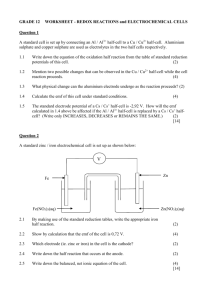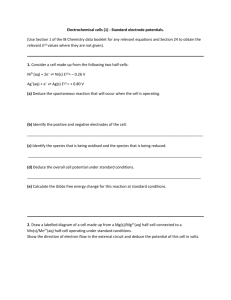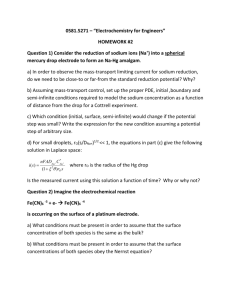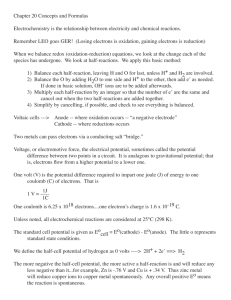File
advertisement
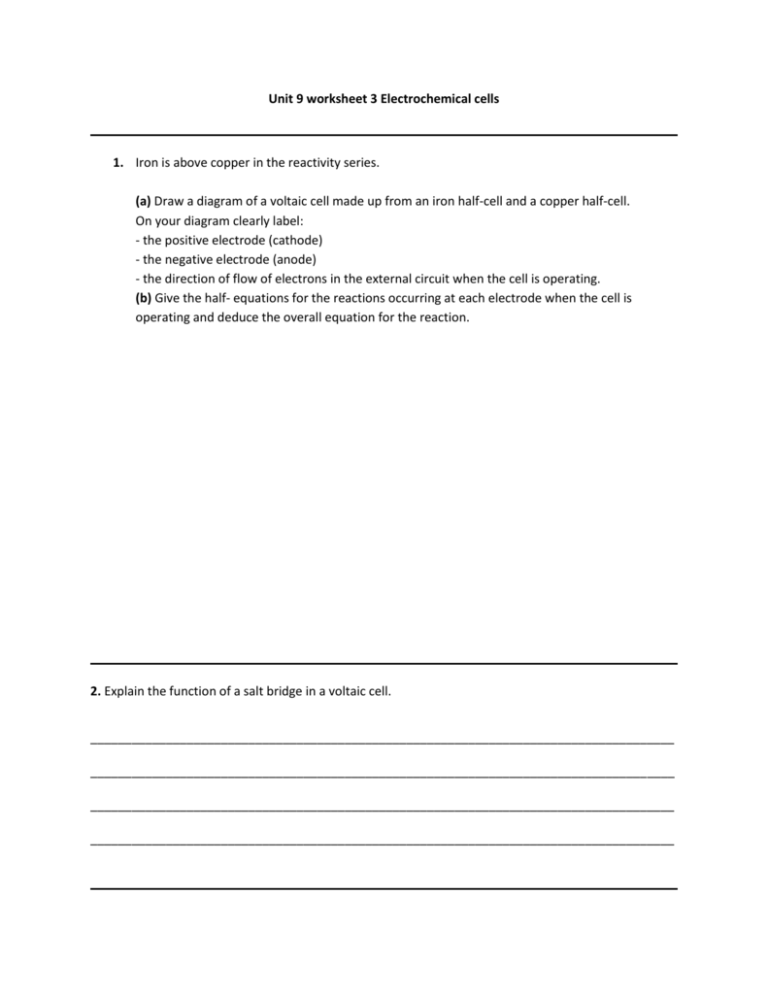
Unit 9 worksheet 3 Electrochemical cells 1. Iron is above copper in the reactivity series. (a) Draw a diagram of a voltaic cell made up from an iron half-cell and a copper half-cell. On your diagram clearly label: - the positive electrode (cathode) - the negative electrode (anode) - the direction of flow of electrons in the external circuit when the cell is operating. (b) Give the half- equations for the reactions occurring at each electrode when the cell is operating and deduce the overall equation for the reaction. 2. Explain the function of a salt bridge in a voltaic cell. _____________________________________________________________________________________ _____________________________________________________________________________________ _____________________________________________________________________________________ _____________________________________________________________________________________ 3. A student carried out an experiment to determine the cell voltage (electromotive force) of several different simple voltaic cells. She obtained the following results: (a) Deduce the cell voltage she would have obtained if she had connected the magnesium half-cell to the iron half-cell. _____________________________________________________________________________________ _____________________________________________________________________________________ _____________________________________________________________________________________ _____________________________________________________________________________________ ____________________________________________________________________________________ (b) Identify the positive (cathode) and negative (anode) electrode when a zinc half-cell is connected to an iron half-cell and state the half-equations and the overall equation when the cell is operating. _____________________________________________________________________________________ _____________________________________________________________________________________ _____________________________________________________________________________________ _____________________________________________________________________________________ _____________________________________________________________________________________ 4. (a) Explain why sodium in both the solid and molten form is a good conductor of electricity whereas sodium in the gaseous state is a poor conductor of electricity. _____________________________________________________________________________________ _____________________________________________________________________________________ _____________________________________________________________________________________ _____________________________________________________________________________________ _____________________________________________________________________________________ (b) Explain why solid sodium chloride is a poor conductor of electricity whereas molten sodium chloride is a good conductor of electricity. _____________________________________________________________________________________ _____________________________________________________________________________________ _____________________________________________________________________________________ _____________________________________________________________________________________ _____________________________________________________________________________________ 5. (a) Draw a labelled diagram to show the electrolysis of molten lead(II) iodide, PbI2(l). (b) (i) State the half-equation for the reaction that occurs at the positive electrode (anode) and name the product. _____________________________________________________________________________________ _____________________________________________________________________________________ _____________________________________________________________________________________ (ii) Identify whether the reaction taking place at the positive electrode (anode) is oxidation or reduction. _____________________________________________________________________________________ (c) (i) State the half-equation for the reaction that occurs at the negative electrode (cathode) and name the product. _____________________________________________________________________________________ (ii) Identify whether the reaction taking place at the negative electrode (cathode) is oxidation or reduction. _____________________________________________________________________________________ 6. (a) Sodium chloride is easily available as it can be bought as ‘table salt’. Explain why it is difficult to perform an experiment in a school laboratory to determine whether or not it conducts electricity when molten. _____________________________________________________________________________________ _____________________________________________________________________________________ (b) Deduce the products formed at the positive and negative electrodes when electricity is passed through molten magnesium chloride and give the half-equations for the reactions occurring. ____________________________________________________________________________________ ____________________________________________________________________________________ (c) During the electrolysis of molten magnesium chloride the current passes from the battery through the wires to the electrodes then through the molten electrolyte. Explain the different ways in which electricity is conducted in (i) the wires and (ii) the electrolyte. Answers 1. (a) (b) Fe(s) → Fe2+(aq) + 2e– Cu2+(aq) + 2e– → Cu(s) Overall equation: Fe(s) + Cu2+(aq) → Fe2+(aq) + Cu(s) 2. A salt bridge enables ions to move from the solution of one half-cell to the solution of the other halfcell and hence completes the electrical circuit between the two solutions. 3. (a) When a magnesium half-cell is connected to a copper half-cell the voltage is 2.71 V and when an iron half-cell is connected to a copper half-cell the voltage is 0.78 V so when a magnesium half-cell is connected to an iron half-cell the voltage will be 2.71 – 0.78 = 1.93 V. (b) A zinc half-cell gives a higher voltage than an iron half-cell when both are connected to a copper halfcell so zinc is more reactive than iron. The positive electrode will be iron and the negative electrode will be zinc. At the positive electrode: Fe2+(aq) + 2e– → Fe(s) At the negative electrode: Zn(s) → Zn2+(aq) + 2e– Overall equation: Zn(s) + Fe2+(aq) → Zn2+(aq) + Fe(s) 4. (a) Sodium is a metal. It contains delocalised electrons which can move from one atom to another and so conducts electricity by the movement of electrons and no chemical change takes place. This can happen when the atoms are in close contact in the solid or liquid state but not when they are far apart in the gaseous state. (b) Sodium chloride is a salt consisting of sodium and chloride ions. In the solid state the ions are held in a fixed lattice and cannot move to the respective electrodes. There are also no free or delocalised electrons in the salt. When molten the ions are free to move to the oppositely charged electrodes where a chemical reaction takes place and electrons are released or accepted. 5. (a) (b) (i) 2I–(l) → I2(g) + 2e– Product: iodine (ii) Loss of electrons so oxidation. (c) (i) Pb2+(l) + 2e– → 2Pb(l) Product: lead (ii) Gain of electrons so reduction. 6. (a) It is difficult to get the salt to melt (the melting point of NaCl is 801 oC) using the heating available (such as a Bunsen burner) in most school laboratories. (b) Positive electrode: Chlorine produced. 2Cl–(l) → Cl2(g) + 2e– Negative electrode: Magnesium produced: Mg2+(l) + 2e– → 2Mg(s) (c) (i) Electricity is conducted by the flow of electrons in the metal wires. (ii) Electricity is conducted by the movement of ions in the electrolyte.
